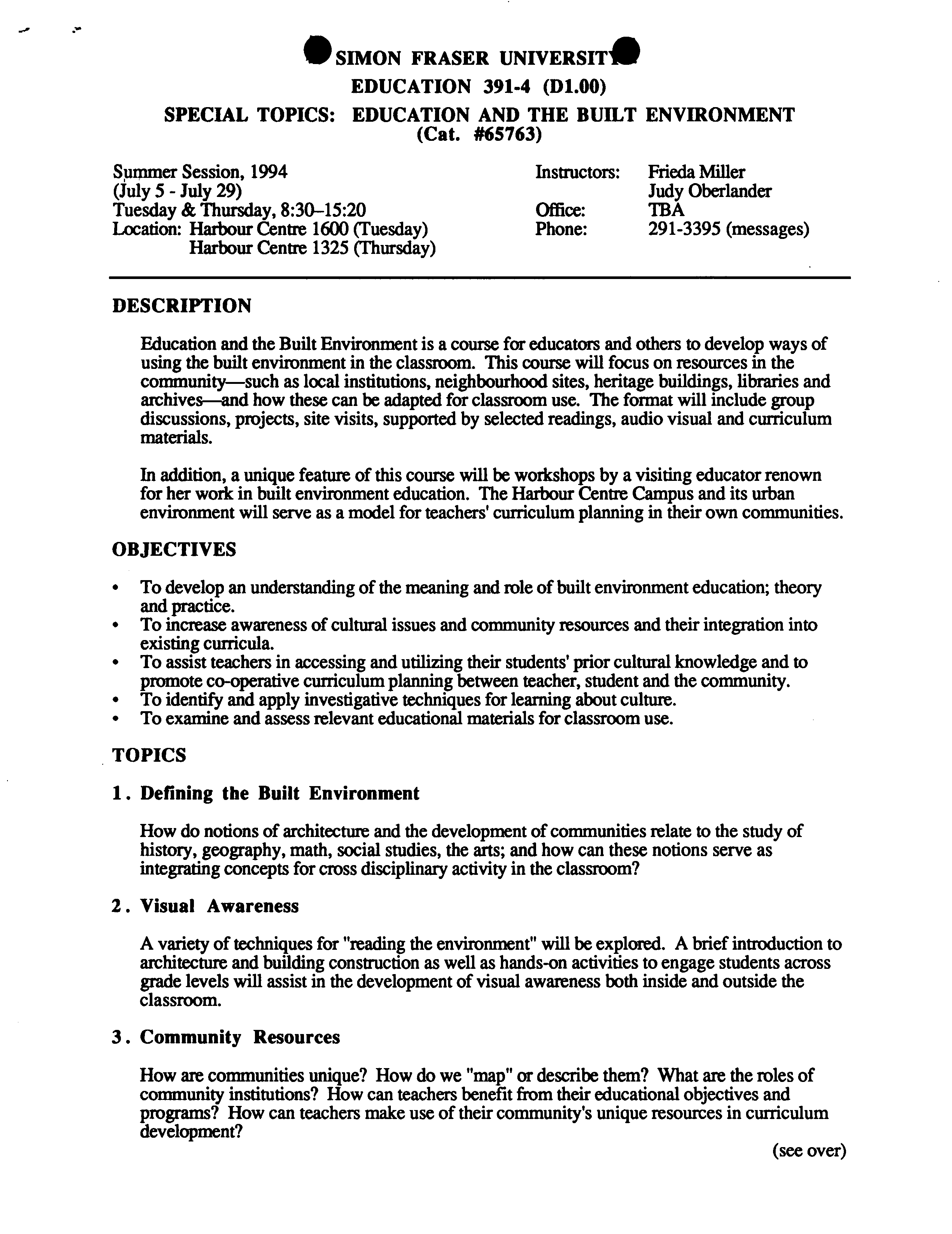S
SIMON FRASER UNIVERSIT•
EDUCATION 391-4 (D1.00)
SPECIAL TOPICS: EDUCATION AND THE BUILT ENVIRONMENT?
(Cat. #65763)
Summer Session, 1994 ?
Instructors: Frieda Miller
(July
5 -
July 29) ?
Judy Oberlander
Tuesday & Thursday, 8:30-15:20 ? Office: ?
TBA
Location: Harbour Centre 1600 (Tuesday) ?
Phone: ?
291-3395 (messages)
Harbour Centre 1325 (Thursday)
DESCRIPTION
Education and the Built Environment is a course for educators and others to develop ways of
using the built environment in the classroom. This course will focus on resources in the
community—such as local institutions, neighbourhood sites, heritage buildings, libraries and
archives—and how these can be adapted for classroom use. The format will include group
discussions, projects, site visits, supported by selected readings, audio visual and curriculum
materials.
In addition, a unique feature of this course will be workshops by a visiting educator renown
for her work in built environment education. The Harbour Centre Campus and its urban
environment will serve as a model for teachers' curriculum planning in their own communities.
OBJECTIVES
• To develop an understanding of the meaning and role of built environment education; theory
and practice.
• To increase awareness of cultural issues and community resources and their integration into
existing curricula.
• To assist teachers in accessing and utilizing their students' prior cultural knowledge and to
promote co-operative curriculum planning between teacher, student and the community.
• To identify and apply investigative techniques for learning about culture.
• To examine and assess relevant educational materials for classroom use.
TOPICS
1. Defining the Built Environment
How do notions of architecture and the development of communities relate to the study of
history, geography, math, social studies, the arts; and how can these notions serve as
integrating concepts for cross disciplinary activity in the classroom?
2. Visual Awareness
A variety of techniques for "reading the environment" will be explored. A brief introduction to
architecture and building construction as well as hands-on activities to engage students across
grade levels will assist in the development of visual awareness both inside and outside the
classroom.
3.
Community Resources
How are communities unique? How do we "map" or describe them? What are the roles of
community institutions? How can teachers benefit from their educational objectives and
programs? How can teachers make use of their community's unique resources in curriculum
development?
(see over)
EDUC 391-4 (D1.00) Coued
?
S
4. Investigative Techniques
How can teachers utilize research and interview techniques, oral histories, photography,
community organizations and professional associations to gain insight into their cultural
environment? How can teachers access and incorporate their students' cultural backgrounds
and knowledge? What are some of the educational materials, resources, and teaching strategies
available to the teacher?
STUDENT ASSIGNMENTS
Site Analysis:
Participants will select and analyze a building or heritage site as a potential source for
curriculum development. This will include a preliminary baseline description, an interview
with a member of the community and research of available material. The end product would be
a prototype resources package and lesson plan for the teacher's personal use and for sharing
with other members of the class.
Planning a Site Visit:
Participants will develop a plan for a class site visit which includes preparatory and follow up
lessons or activities. The rationale for the plan must include its relevance to the learners'
cultural environment and its integration within the curriculum. Again these projects would be
shared among the members of the group.
Site Unit Plan:
Using the same site, participants will develop a detailed unit plan which can be integrated into
variety of subject areas including social studies, history, geography, art, math, or science.
Participants will be encouraged to use a variety of media and to develop materials which they
can use within the context of their own teaching.
ASSESSMENT AND GRADING PROCEDURE
The assignments will be graded as follows:
Site Analysis..................................30%
Planning a Site Visit.........................30%
Site Unit Plan.................................30%
Weekly Response Sheets ...................10%
REQUIRED TEXTS
Abhau, Marcy, Copeland, Rolaine, and Greenberger, Greta.
Architecture in Education.
Philadelphia: Foundation for
Architecture, 1986.
Chalmers, Graeme and Moorcroft, Frances.
British Columbia Houses: Guide to the Styles
of
Domestic Architecture in British Columbia,
A Workbook for Secondary Art & Home
Economic Students.
Vancouver: WEDGE
(Western Educational Development Group), Center
for the Study of Curriculum and Instruction, University of British Columbia, 1981.
Taylor, Anne, Viastos, G. & Marshall, A.
Architecture and Children: Teachers Guide.
Seattle,
Washington: Architecture and Children Institute, 1991.
PARTICIPANTS WILL BE ASKED TO BRING SLIDES OR PHOTOGRAPHS AND/OR A
SMALL ARTIFACT RELATED TO THE BUILT ENVIRONMENT TO THE FIRST SESSION
OF THE COURSE.


